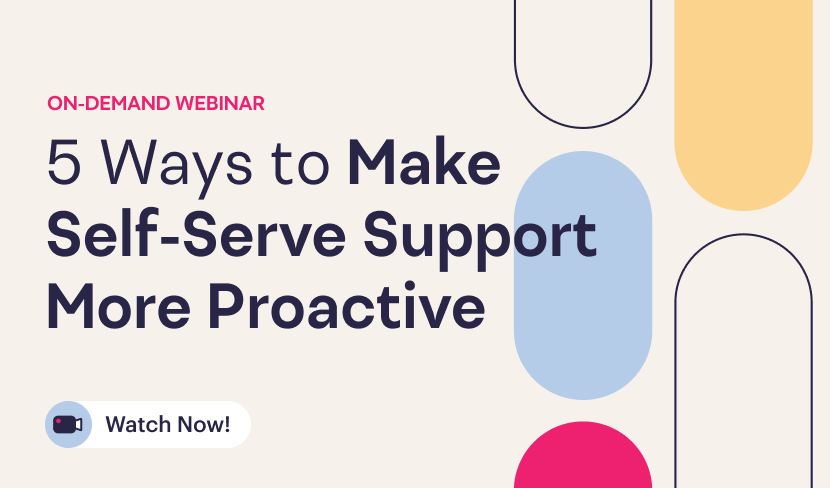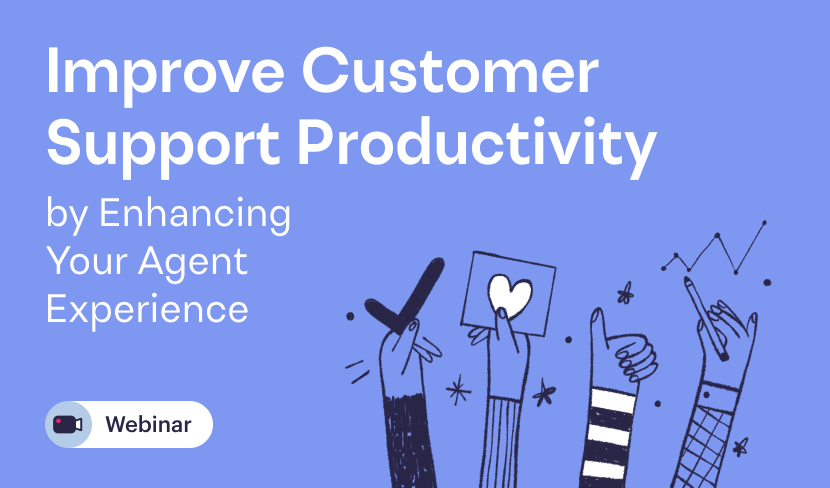Customer support leaders at online marketplaces arguably have one of the most difficult roles. They’re expected to maintain trust with buyers, make sellers successful, and improve agent productivity.
Since it only takes two negative experiences for 80% of customers to consider switching to a competitor, the stakes have never been higher for marketplaces to offer memorable experiences that keep buyers coming back and new sellers signing up.*
So how do you continue offering excellent support quality while resolving mission-critical issues that frustrate your agents and customers? We’ve identified the major challenges support leaders should prepare for and opportunities to overcome them.
1) Onboarding sellers requires human intervention
Onboarding sellers is a business-critical activity for marketplaces. When a seller first signs up to your marketplace, they’re the most engaged they’ll ever be in their entire customer lifecycle. It’s your opportunity to make the most significant impact on their success.

When done right, a great onboarding program should seem personalized and prevent sellers from contacting support or churning. It deepens the adoption of your marketplace and brings immediate value to sellers by preventing them from skipping onboarding altogether.
It’s complicated and costly to scale 1:1 onboarding programs for every seller. To combat this, you may choose to automate onboarding and support functions for smaller sellers. While this may seem to solve the problem of onboarding smaller customers at first, it won’t work in the long run.
That's because onboarding needs vastly differ from one seller to another depending on their size, comfort level with technology, business maturity, etc. You may have already added onboarding tours to your marketplace, but those may be too generic for various seller scenarios. Onboarding that lacks personalization will result in customers feeling deflected and undervalued.
One essential part of the onboarding process is optimizing the seller’s listing. An optimized listing may include commonly searched terms, relevant purchase and shipping information, high-quality product photos, etc. For example, like many marketplace customers, Etsy's customers are not marketing or technology professionals. If Etsy doesn’t offer the sellers resources or tips to optimize their listings, their sellers may not be successful enough to continue selling on their marketplace.
Opportunity: A more scalable and personalized way to onboard sellers
Instead of relying solely on 1:1 training or generic onboarding tours, add proactive, personalized guidance when and where your sellers need help.
Begin just like your 1:1 onboarding by getting to know the seller with intent questions:
- Who are they?
- What are their goals?
- What do they already know or do not know?
- What job are they using your product or service to do?
Then, provide a best-fit path to guide them through their onboarding using step-by-step guides and personalized checklists so your sellers don’t miss an important step or detail.
Continue to provide always-on help to optimize the seller’s listing and empower them to get more value from your marketplace. With the right mix of seller resources, you can ensure that listings on your marketplace, be it a seller’s first or hundredth, consistently attract buyers and increase sales conversions.
As your sellers create listings, they should be able to access on-page help to determine image sizes and resolution, the ideal character limit for product titles and descriptions, keyword suggestions, and so on. For example, a new seller may have trouble understanding where and how to use keywords. Offering them tips and guidelines could help them sell better. You could also recommend free tools or share additional resources to help them identify the right keywords for their product listing.
2) Serving two groups of customers leads to strained teams and excessive tickets
Sellers and buyers experience different pain points. That means your agents are required to switch contexts often. Or, you may have to separate your buyer and seller support teams, incurring more resources to manage two different operating teams.
Tickets from sellers often tend to be complex, more business-critical, and lower in volume. On the other hand, buyers tend to have repetitive questions that result in many tickets. For example, a buyer query on a promotional code is straightforward and requires less mental load than a refund request involving both buyers and sellers.
Any large repetitive queries that are self-solvable hinder your agents’ productivity. Their focus shifts from offering extraordinary seller experiences to resolving buyer tickets quickly.
Opportunity: Automated, contextual self-serve support right at the point of need
Instead of leading customers to a 5-page help article, you could break each resolution into steps based on customer scenarios and choices.
For example, depending on whether customers use an iOS or Android device, they may need to take different steps to resolve issues. Customers that use an iPhone don’t want or need to see information that isn’t relevant to them. In this scenario, you could use available customer data to only display relevant steps for their device. Or, if the right data isn’t available, you could rely on pathing and choices to help guide customers to the right resolution for their device.
Anedot currently serves two different types of customers: 1) customer organizations with setup questions and 2) individual donors with troubleshooting questions. Between the two of them, their team needed help managing a heavy ticket volume of 2,000 to 3,000 tickets per month.
By replacing their help center articles with Stonly guides, Anedot cut down onboarding and activation times for both customer groups.
Read how Patrick O’Keefe, Vice President of Customer Experience at Anedot, enables his team to proactively support both sides of their fundraising marketplace.
3) Losing sales due to unaddressed questions, confusion, or hesitation
Marketplace agents must make buyers feel comfortable during the buying process. If a buyer asks a question, agents must sound knowledgeable, which is exceptionally difficult with such a diverse range of products.
From the buyer’s perspective, unanswered questions or difficulty finding what they’re looking for is very frustrating.
If it doesn’t seem easy to find the answers or get the help they need, 80% of your buyers may abandon the purchase altogether, according to Oberlo.
Opportunity: Proactive self-serve guidance to accelerate sales conversions
Only 4% of unhappy customers reach out to support—the rest churn, according to a CX survey conducted by former Gartner Analyst Esteban Kolsky. You can avoid silent churn by displaying help content where needed, preventing buyers from leaving your website when they need more information. For example, you can use tooltips on product and checkout pages to answer questions or provide more details during the purchasing process. Proactively offering contextual information reduces hidden surprises and lowers buyer hesitation.
"Being able to place tooltips in our app with no code is a game-changer, allowing us to help users right where they need it.”
- Octavian Maxim, Head of Product & Growth, Testable
Rather than making customers leave the page to find help, make your entire help center available on every page of your marketplace with an unobtrusive “?” pill. A pill allows buyers to access all your help content with a single click from anywhere on your website. So now, instead of searching for an answer on Google or your help center, your buyers can find all the information they need to feel more confident about their purchase without leaving the page they’re on.
For critical or seasonal updates, you could use banners or popups to relay relevant information to customers. For example, if bad weather is delaying shipments for a majority of your sellers, a proactive popup or banner can help you keep buyers in the loop and prevent them from contacting agents or sellers about shipping timelines.
If self-service doesn’t help buyers resolve issues, you could go further by adding help content within your contact form so buyers can self-serve before contacting your team. Whenever a customer has to contact support, pass relevant contextual information to agents. When your agents can access customer information and activity tracking, they can offer faster resolutions or route questions back to the seller without making the customer repeat themselves.

4) Managing issues and disputes between sellers and buyers is notably complex
When it comes to your buyers, you and your sellers share the responsibility of addressing concerns and disputes. Some issues must be routed to and handled directly by the seller, and others by the marketplace.
Your agents can’t memorize every product on your marketplace, know the exact refund and return policy each seller offers, or remember how each seller prefers to resolve disputes. Often, this information isn’t easy to find because it’s stored in different documents or requires more senior employee involvement.
As a result, something as simple as refund requests can be incredibly complex if your agents don’t have on-demand access to the right information.
Opportunity: Step-by-step agent resources, workflows, and support processes
To reduce the complexity, provide agents with all post-purchase rules in a step-by-step format that’s available within their ticketing software, a centralized knowledge base, and any other tools they use regularly. Guidance should be accessible within their workflows to minimize interruptions to their productivity.
For example, electronic product warranties vary by device and are often complicated and situation-based. Instead of having agents rely on product manuals, break complex and technical information into steps and create paths for each scenario. These choices enable your team to easily navigate to specific sections of the warranty policy and guide buyers on how to file a claim.
If a customer can’t resolve an issue independently, make the hand-off from self-serve to live support seamless. Use your contact form to ensure your tickets give agents all relevant information, such as buyer name, order ID, the issue they’re experiencing, and what self-service steps they’ve already taken. Collecting the right information helps ensure the inquiries are routed to the right person, whether it’s on your support team or the sellers’.
Some tickets may need to be routed to the seller. To make this hand-off seamless, your sellers may need to use tools that are compatible with your teams’ to manage tickets and order-related information. Often, email help desks are best suited for marketplace sellers.
Ensure you consult with sellers on what they’d like your team to handle and what issues they’d prefer to come directly to them. With the right mix of processes and technology, your agents should be able to transfer relevant customer data and contextual information to the seller with a few clicks.
The same procedure should apply to your sellers when they need your team to step in. This approach helps you avoid errors caused by manual input and create a better experience for agents and sellers.
You may also want to consider providing sellers with step-by-step workflows and checklists so they never miss an important step and consistently offer great customer experiences.

5) Keeping consistently high support quality across sellers is challenging
Offering consistent support quality is difficult when sellers are involved because it adds a lot of variables that your team has to deal with. In addition, the more sellers you have, the harder it is to ensure everyone offers similar support experiences.
When your sellers and team aren’t aligned, it can create a disjointed experience for the buyer. For example, let’s consider that one of your sellers doesn’t offer a return or refund on a final sale item. However, their general store policy allows for returns and exchanges for other items. Without this context, your support team could be giving buyers false hope. Or worse, they may authorize the return/refund only to have the seller dispute the transaction. This is a frustrating situation for both sellers and buyers.
Opportunity: Empower customers, sellers, and agents with the knowledge they’ll need
Give your customers and agents the option to self-solve as many inquiries as possible, but don’t force it. Here’s how you can create excellent help content for each end-user.
For your buyers, you’ll want to create a help center that addresses issues that drive the most tickets and lead to fewer sales. For example, you could create a help article on disputes so buyers understand who to contact first and what they can expect when contacting support.
Your sellers are more likely to need assistance during disputes. Giving them the right guidance 24/7 through self-service can help them resolve buyer queries without creating a ticket. Before creating help content, standardize support processes and get seller input. Then, build your help content for different scenarios and give your sellers choices for easy navigation.
Your agents need contextual information to assist customers based on their use case. A searchable agent knowledge base can help them find the next steps without involving an SME. This ensures support team members have access to on-demand guidance and resolve tickets.
“We have had the most success by having process flows in Stonly that keep employees from skipping or missing crucial steps. Stonly allows creativity in the procedure creation phase and encourages procedural compliance in the execution phase.”
~Brian Lauber, Director of Operations at Shift4
Since agents, sellers, and buyers can use some of the same content for specific issues, you may find it more efficient to leverage some of the same content and possibly unify your help center for buyers and sellers. You’ll want to ensure that each end-user can find relevant information through categories or sections designed for each group.
Create Seamless Experiences For Your Marketplace Customers
Extraordinary support experiences are critical to retaining marketplace customers—especially for first-time visitors. However, creating powerful guidance that adapts to both seller and buyer scenarios at scale is challenging.
Stonly’s step-by-step, adaptive guidance allows you to uniquely deliver the right content and service level for each end-user exactly where they’ll need it. You can help your sellers get the most out of your platform and lead more buyers to success with real-time and proactive self-service. As an added benefit, you free up agent workload and allow them to tackle more complex issues while offering incredible support experiences.
Want to learn how you can support buyers and sellers at scale? Schedule a consultation to learn how to offer personalized support for both sides of your marketplace without sacrificing quality.
*Statistic source: Zendesk

